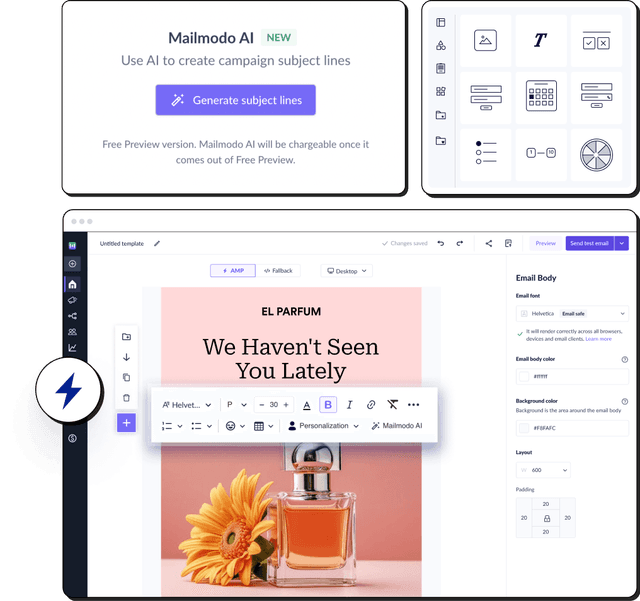8 Transactional email best practices to follow
Here are seven best practices for transactional emails you can employ:
1. Don’t use “no-reply” email addresses
As a customer, there’s nothing more frustrating than having a question in your mind and not knowing where to get it answered. And, nobody likes to receive and conversate with emails from these strange reply addresses When sending transactional emails from a no-reply email address, you limit your customers’ interactions.
On the other hand, adding a “reply-to email address” offers these two major benefits:
It shows customers you welcome any communication and are all ears for what they say.
If your customers reply, that email is automatically added to your subscriber list.
So, to improve your customer service as an online business, make sure you are using a reply-to email to get customer loyalty.
2. Provide clear and relevant details
Here are some of the things you should do to ensure transactional emails offer value to the user:
Include a clear “from” address. This gives your recipient an idea about the email and helps with inbox management. For example, “support@domain.com” is used to reply to any queries (technical advice, instructions, etc.) users might have.
Write a clear and concise subject line telling the user what the email is about. The recommended subject line length is around 60 characters or nine words.
Use relevant preheader text to tell the reader further what the emails contain.
Check out these free transactional email templates.
3. Safeguard your email message
Avoid potential email breaches and loss of customer trust by safeguarding your emails. You can ensure these email security practices by using these three authentication protocols:
- Sender Policy Framework (SPF)
SPF is an email authentication standard that protects you against phishing, spoofing, and spam.
- Domain keys identified mail signature (DKIM)
DKIM is an email security standard used to ensure messages are not modified while traveling between the recipient and sending servers.
- Domain-based message, authentication, reporting, and conformance (DMARC)
DMARC is a protocol that builds on DKIM and SPF to tighten the protection of your domain from fraudulent emails.
You should not limit your transactional emails to just confirmation and acknowledgment of interactions with a user. They can also act as a marketing email by updating you on items on your wishlist.
Adding social links to your emails can help you gain more traction. In the below image, Nintendo tempts its customers with a lucrative offer, and its social media icons are displayed notably at the bottom.

Social media link sharing in a transactional email helps keep your customers engaged after the email is closed. Even if there’s no clear CTA, they could always check your social media profiles for more deals and prices.
Another benefit is that if the recipient is not interested in what you are offering, they might follow your socials to get similar deals in the future.
5. Use a separate domain and IP address
Your transactional emails should be sent from a different domain and IP address than your bulk marketing emails like promotional, cart abandonment, re-engagement, etc.
Why? Marketing emails are more likely to receive complaints and be flagged as spam.
If your transactional emails are sent from the same IP and domain, they may be considered similarly.
While screening emails, whether marketing or transactional, mailbox providers consider domain and sending reputation. If you pick a bad one, your emails will land in promotions or spam folders.
Now, how can you keep your transactional and marketing emails separate? By following these tips:
By providing separate IP addresses for transactional and marketing emails. For example, for a subscription confirmation, you can use subscription-confirmation@domain.com as a transactional email and offers@domain.com for marketing emails.
Avoid using the same domain or subdomain names for both types of email.
Use different servers to send transactional and marketing emails to prevent blacklisting issues.
6. Always include a plain text version of your email
Giving your readers the option of receiving plain text emails rather than image-filled versions is always a smart idea. Your email deliverability and accessibility will both increase due to this.
While creating the plain text version, keep in mind that the text and the HTML version of email content should not differ much.
7. Choose a reliable email services provider
There are a lot of transactional email providers out there. So, do a little bit of digging to choose one that fits your needs and gives the quality you need while staying within your budget.
Examine the benefits and drawbacks of each transactional email service provider you’re considering to find the best fit for your needs and serves your primary purpose.
8. Use responsive email templates
46% of people with smartphones these days prefer to read their emails on mobile devices. So, to make sure most of your recipients are receiving and reading your emails, use responsive design. Responsive design of your emails will make sure that the customer can read your email on all screen sizes, whether its a smartphone screen or a laptop screen.
Send transactional emails seamlessly with Mailmodo
You’ve seen how transactional emails may be used in tandem with marketing emails to provide a consistent brand experience across the customer journey.
Mailmodo’s transactional email service lets you do exactly that. You can set up different triggers, including API, Webhooks, CRMs, etc. You can also send interactive, transactional emails that include carts, carousels, calendars, etc., in the email itself.
Making your transactional emails more marketing-like might really provide you a competitive edge!










